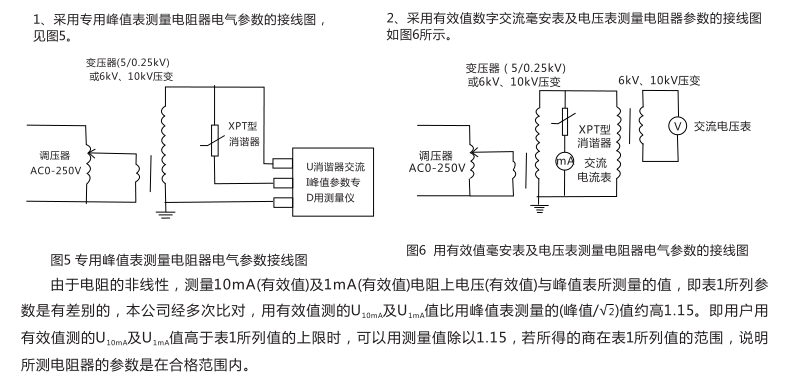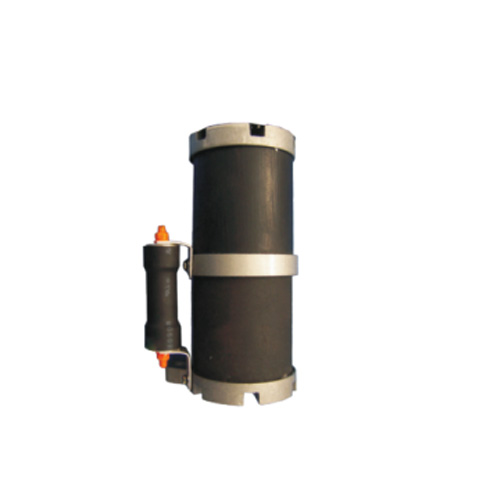XPT type harmonic elimination resistor and its accessories
1. Overview
The electromagnetic voltage transformer (hereinafter referred to as PT) in the 6~35kV neutral point ungrounded power grid, when the bus is unloaded or there are few outgoing lines, it will be excited due to the closing charging or the elimination of ground faults during operation. If the voltage transformer is oversaturated, it may produce ferromagnetic resonance overvoltage. Unstable voltage relative to ground, malfunction of ground indication, blown PT high-voltage fuse and other abnormal phenomena will occur. In severe cases, the PT will be burnt out and other accidents may occur.
For example, the neutral point of the 6~35kV power grid is not grounded, and the busbar is Y. The connected PT primary winding will become the only metallic channel of the grid to the ground. When single-phase grounding or disappearing, the grid-to-ground capacitance will have a transition process of charging and discharging through the PT primary winding. At this time, there is often a power frequency half-wave surge current with the highest amplitude of several amperes passing through the PT. This current may blow the PT high-voltage fuse (0.5A). The electronic resonance elimination device installed on the secondary side of the PT generally cannot eliminate the inrush current.
XPT type, XPT (D) type harmonic elimination resistors are installed in the primary winding Y of 6~35kVPT. The high-capacity non-linear resistor between the neutral point of the wiring and the ground plays the role of damping and current limiting, eliminating the voltage-transformation ferromagnetic resonance and preventing the single-phase high-voltage fuse from fusing. The accessory "third harmonic limiter" installed at both ends of the open triangle of the voltage transformer residual voltage winding can limit the voltage drop of the voltage transformer third harmonic current and fundamental unbalanced current on the resonance eliminator to a certain range. At the same time, the voltage across the harmonic elimination resistor in the primary winding is also reduced. The voltage on the harmonic elimination resistor can be reduced to less than a quarter of the original value. This is more beneficial for the voltage change whose neutral point is low insulation and long-term operation at low voltage (less than 100V).
2. Product features
The resistor body of the resonance eliminator adopts SiC as the base material, and the connecting body adopts die-cast aluminum or copper, which is small in size, light in weight, high in strength, easy to dissipate heat, and easy to install.
The product adopts a single-chip large-current non-linear resistor, which eliminates the uneven current flow in the original multi-chip parallel structure resonance eliminator, and the performance is more stable.
If current flows through the resonance eliminator when it is in use, the high voltage generated by it is directly applied to the neutral point of the PT, which may burn out the neutral point insulation of the weakly insulated PT. The resonance eliminator provides a resonance eliminator with a D parameter element (with D type) for weakly insulated PTs. This element can effectively limit the voltage at both ends of the resonance eliminator and protect the neutral point insulation.
The size of the harmonic eliminator is smaller, especially suitable for PT cabinets and handcart cabinets. The whole harmonic eliminator has no porcelain sleeve and there is no danger of explosion.
After running, the voltage transformer cabinet is equipped with a resonance eliminator. It is inconvenient to install the accessories on the panel of the transformer cabinet, and it is necessary to reduce the voltage rise at both ends of the open triangle. A simple accessory can be configured and directly connected to the opening of the terminal block. The two ends of the triangle da and dn are used to reduce the rise of the open triangle voltage caused by the resonance eliminator.
XPT type resonance eliminator adopts the characteristics that the excitation current under most voltage transformer rated line voltage is greater than 10mA (peak value/√2), and the voltage on the resistance with AC 10mA (peak value/√2) current is greater than the voltage transformer rated line voltage 6 % To calibrate the resistance value, so the relationship between the resistance value of the resonance elimination resistor and the required resonance elimination resistance value is very clear. It is more reasonable to calibrate the resistance value of 1mA (peak value/√2) with a non-linear coefficient greater than the rated line voltage and phase voltage of the voltage transformer to establish the electrical parameters of the resonance eliminator.
3. Electrical wiring
The electrical wiring diagram of XPT resonance eliminator and its accessories is shown in Figure 1. The resistor is connected between the neutral point of the primary winding of the voltage transformer and the ground, and the accessories are connected to both ends of the open triangle of the voltage transformer. The AC100V power supply is provided by the voltage of the secondary winding of the voltage transformer, and the required power is not more than 5VA. If you use a simple accessory, you only need to screw the two supporting wires of the simple accessory directly on both ends of da and dn of the terminal block.

4. Main electrical parameters
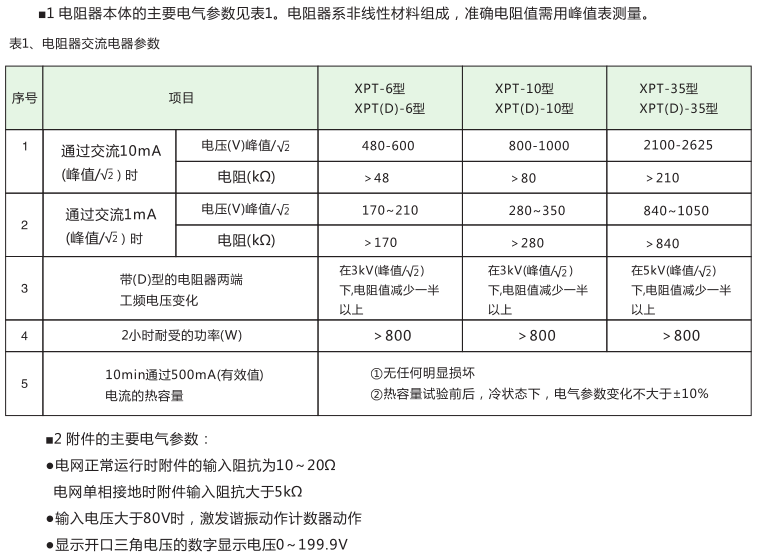
5. Selection principle
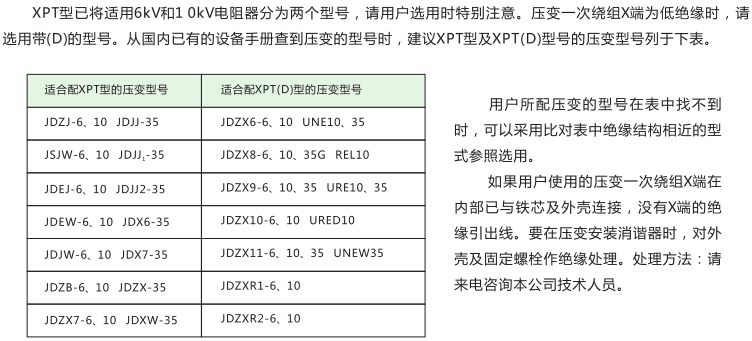
6.外形尺寸
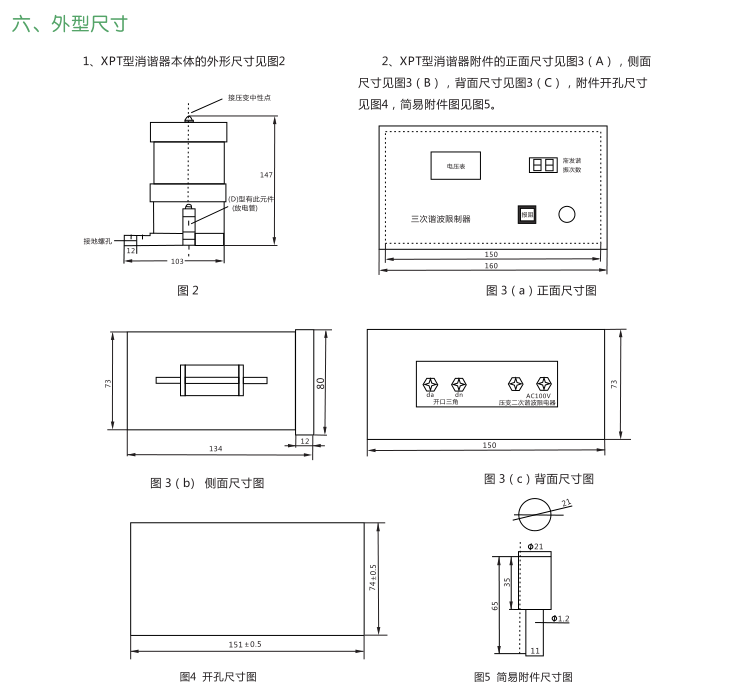
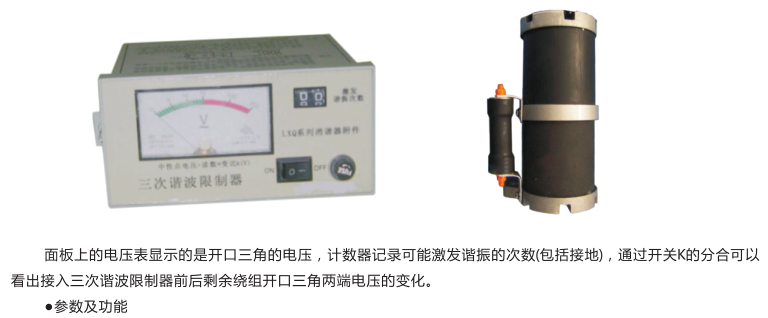
1. In normal operation, R=10~20Ω, when 80V, R≥22kΩ, R is the internal resistance of the limiter (when K is closed).
2. When the input voltage is greater than 80V, the resonance counter will be activated.
3. Display the voltage range of the open triangle: 0~200V.
7. Installation and operation
1. XPT-type harmonic eliminators are generally installed indoors. Years of operating experience has proven that they can also be installed outdoors. When installing in a pressure change cabinet, it is generally installed vertically. If the vertical installation in the cabinet is not well arranged, it can also be installed horizontally.
2. The distance between the resistor body and the live body installed in the voltage transformer cabinet should meet the requirements of the national standard "3~110kV high voltage power distribution device design specification" for the safe clear distance between the live body and the grounding body. The distance between the upper end of the resistor body and the grounding body should not be less than 20mm.
3. The upper end of the resistance body of the XPT resonance eliminator has an insulated wire about 1m long. The insulated wire can be laid in the air or along the cable board.
4. The accessory of the XPT resonance eliminator needs to be installed on the panel of the voltage transformer cabinet or the panel of the control cabinet, which is convenient for operators to observe. For the operation of accessories during operation, there are text instructions on the accessory panel, please operate according to the instructions.
5. Installation and operation of simple accessories of XPT type harmonic eliminator: the simple accessories can be directly fastened to the terminal block with the open triangular contact of voltage change, and the two copper wires of Φ1.2 of the simple accessories can be fastened to the terminals On the da and dn contacts of the row. If the voltage change is in operation, a screwdriver with an insulated handle can be used for live installation. Before installation, use a multimeter to measure the voltage between da and dn. If the voltage between da and dn of the terminal block is between 3~15V, it means that the primary winding of the voltage transformer is connected with a harmonic elimination resistor. After installing the simple accessories, the voltage drops to about one-tenth of the original value. If the simple accessories are not installed, and the voltage is between 0.3V and 3V, the harmonic elimination resistor connected to the primary winding may be short-circuited, and the insulation of the neutral point of the voltage change needs to be carefully checked. If the voltage transformer is out of operation when the simple accessory is installed, after installing the simple accessory, when the voltage transformer is running, measure the voltage across da and dn in time to check whether the two ends of the voltage transformer open triangle and the resonance eliminator are short-circuited. Because simple accessories do not have an alarm function, manual inspection is required to ensure the safety of pressure changes.
8. Harmonic elimination body parameter measurement
The company is equipped with a "special measuring instrument for AC peak parameters of harmonic elimination resistors", which can easily measure the AC voltage (peak/ √2). Please note that because the resistor is a non-linear resistor, the current flowing through the non-linear resistor and the voltage on the resistor are not sine waves. The value measured by an ordinary milliamp meter and voltmeter is different from the value measured by the peak meter. , Considering that the user has difficulty in measuring the peak value, here are two measurement methods and mutual comparison coefficients.
